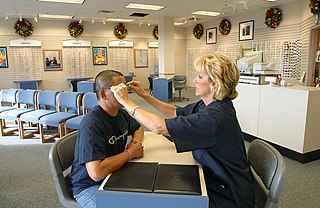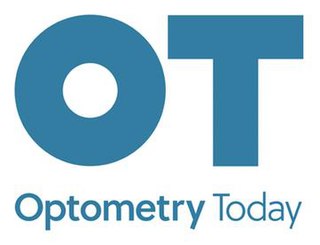
A dioptre or diopter, symbol dpt, is a unit of measurement with dimension of reciprocal length, equivalent to one reciprocal metre, 1 dpt = 1 m−1. It is normally used to express the optical power of a lens or curved mirror, which is a physical quantity equal to the reciprocal of the focal length, expressed in metres. For example, a 3-dioptre lens brings parallel rays of light to focus at 1⁄3 metre. A flat window has an optical power of zero dioptres, as it does not cause light to converge or diverge. Dioptres are also sometimes used for other reciprocals of distance, particularly radii of curvature and the vergence of optical beams.

Bifocals are eyeglasses with two distinct optical powers. Bifocals are commonly prescribed to people with presbyopia who also require a correction for myopia, hyperopia, and/or astigmatism.

Optometry is a specialized health care profession that involves examining the eyes and related structures for defects or abnormalities. Optometrists are health care professionals who typically provide comprehensive primary eye care.

The Worshipful Company of Spectacle Makers is one of the Livery Companies of the City of London, UK.

An optician is an individual who fits eyeglasses or contact lenses by filling a refractive prescription from an optometrist or ophthalmologist. They are able to translate and adapt ophthalmic prescriptions, dispense products, and work with accessories. There are several specialties within the field.
Robert Gurth Hughes is a British Conservative Party politician, who was a Government Minister in the 1990s.

Rodenstock GMBH is a German manufacturer of ophthalmic lenses and spectacle frames. The company, which was founded by Thuringian Josef Rodenstock in 1877, is headquartered in Munich.

The College of Optometrists is the professional, scientific and examining body for optometry in the United Kingdom, working for the public benefit. Their headquarters is at 41-42 Craven Street, London WC2, of which no 41 is a Grade II listed building.
An eye care professional is an individual who provides a service related to the eyes or vision. It is any healthcare worker involved in eye care, from one with a small amount of post-secondary training to practitioners with a doctoral level of education.

Pupillary distance (PD), more correctly known as interpupillary distance (IPD) is the distance in millimeters between the centers of each pupil.

Fixation disparity is a tendency of the eyes to drift in the direction of the heterophoria. While the heterophoria refers to a fusion-free vergence state, the fixation disparity refers to a small misalignment of the visual axes when both eyes are open in an observer with normal fusion and binocular vision. The misalignment may be vertical, horizontal or both. The misalignment is much smaller than that of strabismus. While strabismus prevents binocular vision, fixation disparity keeps binocular vision, however it may reduce a patient's level of stereopsis. A patient may or may not have fixation disparity and a patient may have a different fixation disparity at distance than near. Observers with a fixation disparity are more likely to report eye strain in demanding visual tasks; therefore, tests of fixation disparity belong to the diagnostic tools used by eye care professionals: remediation includes vision therapy, prism eye glasses, or visual ergonomics at the workplace.

The Association of British Dispensing Opticians (ABDO) is the main professional association for opticians in the UK.

The eye care system in Ghana can be said to be one in its infant or growing stages. Today there are less than 300 eye care professionals taking care of the eye needs of over 23 million Ghanaians.

John Browning was an English inventor and manufacturer of precision scientific instruments in the 19th and early 20th centuries. He hailed from a long line of English instrument makers and transformed the family business from one dealing in nautical instruments to one specialising in scientific instruments. Browning was particularly well known for his advances in the fields of spectroscopy, astronomy, and optometry.
Eye care in the United Kingdom is available through the National Health Service. Eye care in the community is almost entirely provided by optometrists in private practice. Specialist NHS services are provided from a small number of eye hospitals, and their staff often run clinics in general hospitals in their region.

The Association of Optometrists (AOP) is the leading representative membership organisation for optometrists in the United Kingdom.
The Optical Confederation is a British trade association launched in April 2010. It is said to help the optometric profession to "punch well above its weight". Lobbying is one of its key activities. It agrees on advice to opticians with the Department of Health about the administration of NHS sight tests and what fees practitioners can claim. It also issues guidance on professional issues which apply to the entire optical sector, such as the prevention of abuse of vulnerable patients.

Dean Evan Hart, O.D., M.A., M.S., B.S., A.A.S., F.A.A.O. is an American scientist, clinical optometrist, professor, and the founder of Woodbury Ophthalmic Group and Woodbury Optical Studio. Dean ran for Nassau County Legislature in 2015. He was a candidate for the New York State Assembly in the 15th Assembly District of the 2016 election. Hart also ran for town office in 2017.

Optometry Today is a professional magazine, published bimonthly by the Association of Optometrists in the United Kingdom.
Samuel Black was a British public relations manager involved in the founding of the Institute for Public Relations in 1948, and the International Public Relations Association (IPRA) in 1955. He wrote eighteen books on the subject of public relations and organised over 200 exhibitions all over the world showcasing the British industry. This work in exhibitions gained him an MBE in 1969 for Services to Export.















